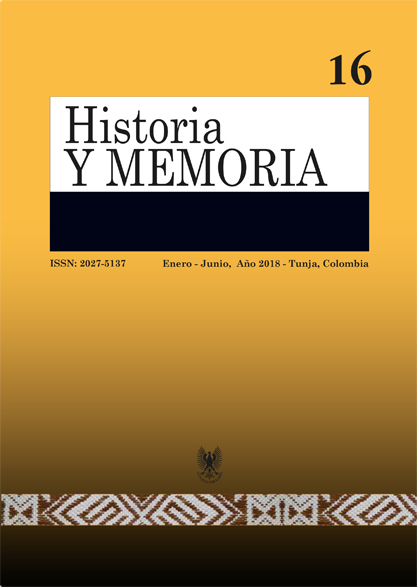Routes for the Circulation and Exchange of Salt in the Province of Tunja, second half of the XVI century

Abstract
This paper examines the way in which trade routes for circulation of salt in the Province of Tunja contributed to the coniguration of an extensive economic territory, integrating the provinces of Santa Fé, Pamplona and Tunja in the New Kingdom of Granada during the XVI century. The research initiates from a historiographic relection related to the circulation and commerce of salt, its transport media and trade routes used by the natives and spaniards. These routes consolidated an economic space mediated by the production and distribution of salt, which transformed the Province of Tunja into an axis that articulated relations between salt production locations in the province of Santa Fe and its consumers in the provinces of Tunja and Pamplona. This regional articulation enabled the circulation of products from different thermal loors, as well as the integration of an ample colonial territory. The location of Tunja as a crossroads between the Provinces of Santafe, Pamplona and the San Juan Plains, made this city and its surroundings into an attraction for Spanish settlement. Likewise, during the second half of the XVI century, this condition triggered the organization, throughout the province of Tunja, of different places of lodging, sale and resale of products of the earth as well as imports from Spain, for the sustenance and supply of basic needs. These places enabled the circulation and exchange of local products such as salt, hayo, cotton, blankets and others.
Keywords
Production, Distribution, Province of Tunja, Commerce, Salt, Trade Routes.
References
- Fuentes documentales
- Archivo General de Indias (AGI), Sevilla – España, Santafé.
- Archivo General de Indias (AGI), Sevilla – España, Patronato.
- Archivo General de la Nación (AGN), Bogotá – Colombia, Fondo Visitas Boyacá.
- Bibliografía
- Acuña Rodríguez, Blanca Ofelia. «Territorio Indígena de la sal en la Sierra Nevada del Cocuy. S. XVI». Historia y Espacio 2, n° 27 (2006): pp. 71-86. DOI: https://doi.org/10.25100/hye.v2i27.4569
- Anónimo. «Descripción de la ciudad de Tunja, sacada de las informaciones hechas por la justicia de aquella ciudad en 30 de Mayo de 1620», Revista Cespedesia, n° 45-46 (1983): pp. 339-372.
- Anónimo, «Relación de Céspedes [1559]», Revista Cespedesia, n° 45-46 (1983): pp. 113-137.
- Assadourian, Sempat. El sistema de la Economía Colonial. Lima: Instituto de Estudios Peruanos, 1982.
- De la Pedraja Tomán, René. «Aspectos del comercio de Cartagena en el siglo XVIII». Anuario Colombiano de Historia Social y de la Cultura, n° 8 (1976): 107-110.
- Friede, Juan. Fuentes Documentales para la Historia del Nuevo Reino de Granada T. V y 7. Bogotá: Banco Popular, 1976.
- Gascón, Margarita.Comerciantes y redes mercantiles del siglo XVII en la frontera sur del Virreinato del Perú». Anuario de Estudios Americanos 57, n° 2 (2000): 413-488. DOI: https://doi.org/10.3989/aeamer.2000.v57.i2.242
- Herrera Ángel, Martha. Ordenar para controlar. Medellín: La Carreta, 2007.
- Langebaek, Carl. Mercados, poblamiento e integración étnica entre los muiscas. Bogotá: Banco de la República, 1987.
- Liehr, Reinhard. «Redes Mercantiles y organización empresarial de un comerciante del centro de México. Mercados Regionales y Atlánticos 1807-1877». América Latina en la Historia Económica 5, n° 9 (1998): 25-39. DOI: https://doi.org/10.18232/alhe.v5i09.216
- Machuca, Laura. Comercio de sal y Redes de Poder en Tehuantepec en la época colonial. México: Centro de Investigaciones y estudios superiores en Antropología social, 2007.
- Martínez, Carlos. Santa Fe. Capital del Nuevo Reino de Granada. Bogotá, Banco Popular, 1988.
- Meisel Roca, Adolfo. «Entre Cádiz y Cartagena de Indias: La red familiar de los Amador, del comercio a la lucha por la independencia americana», Cuadernos de historia económica y empresarial, n° 12 (2004): 34. DOI: https://doi.org/10.32468/chee.12
- Ojeda Pérez, Robert. «Abastecimiento de Santafé antes de la independencia. A propósito de la tienda de Llorente». Tabula Rasa, n° 8 (2008): 147-175. DOI: https://doi.org/10.25058/20112742.326
- Ortiz Cardona, Milena. «Abastecimiento alimentario en Santa Fe Colonial». Trabajo de grado pregrado en historia, Universidad Javeriana, 2009.
- Restrepo, Daniel. Compendio Historial y galería de ilustres varones. Bogotá: Imprenta del corazón de Jesús, 1940.
- Rodríguez Espinosa, Claudia. «Paisaje cultural y redes comerciales. El caso de la cuenca lacustre de Pátzcuaro, Michoacán, en el siglo XVI». Palapa 2, n° 2 (2007): 39-50.
- Sempat Assadourian, Calos. El Sistema de la Economía Colonial. Lima: Instituto de Estudios Peruanos, 1982.
